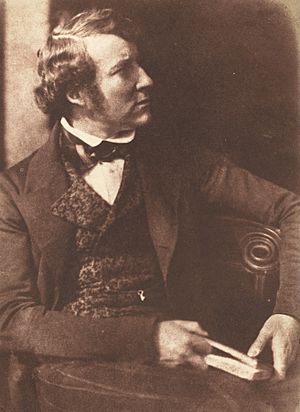John Stuart-Wortley, 2nd Baron Wharncliffe facts for kids
Quick facts for kids
The Lord Wharncliffe
|
|
|---|---|

Circa 1840s, by Hill & Adamson
|
|
| Under-Secretary of State for War and the Colonies | |
| In office 20 December 1834 – 27 January 1835 |
|
| Monarch | William IV |
| Prime Minister | Sir Robert Peel, Bt |
| Preceded by | Sir George Grey, Bt |
| Succeeded by | William Ewart Gladstone |
| Personal details | |
| Born | 20 April 1801 |
| Died | 22 October 1855 (aged 54) |
| Nationality | British |
| Political party | Tory |
| Spouse | Lady Georgiana Elizabeth Ryder (d. 1884) |
John Stuart-Wortley (born April 20, 1801 – died October 22, 1855) was an important British politician. He was known as the 2nd Baron Wharncliffe. He was a member of the Tory political party. For a short time, he worked as the Under-Secretary of State for War and the Colonies in the government. This job involved helping to manage Britain's military and its colonies around the world.
Contents
Early Life and Family Connections
John Stuart-Wortley came from a well-known family called the Stuart family. This family was also connected to the Marquess of Bute. His father was James Stuart-Wortley, 1st Baron Wharncliffe. His mother was Lady Caroline Elizabeth Mary Crichton. John also had two younger brothers, Charles and James.
A Career in British Politics
John Stuart-Wortley had a busy career in politics. He was a Member of Parliament (MP) for several areas. An MP is someone elected by the people to represent them in the British Parliament.
Serving as a Member of Parliament
- From 1823 to 1830, he was an MP for a place called Bossiney.
- Then, from 1830 to 1831, he represented Perth Burghs.
- Later, from 1841 to 1845, he was an MP for the West Riding of Yorkshire.
Working in Government Roles
Besides being an MP, John Stuart-Wortley also held important jobs in the government:
- In 1830, he worked under the Duke of Wellington. He was the Secretary to the Board of Control. This board helped manage affairs in British India.
- From 1834 to 1835, he worked under Sir Robert Peel. He was the Under-Secretary of State for War and the Colonies. This role meant he helped the main minister in charge of military and colonial matters.
Joining the House of Lords
In 1845, John Stuart-Wortley's father passed away. This meant John inherited his father's title and became the 2nd Baron Wharncliffe. With this title, he gained a seat in the House of Lords. The House of Lords is the upper house of the British Parliament. Members of the House of Lords are not elected by the public.
Recognized by the Royal Society
On June 4, 1829, Lord Wharncliffe was chosen as a Fellow of the Royal Society. The Royal Society is a very old and respected group of scientists. Being a Fellow means he was recognized for his interest and contributions to science.
His Family Life
In 1825, Lord Wharncliffe married Lady Georgiana Elizabeth Ryder. She was the daughter of Dudley Ryder, 1st Earl of Harrowby. They had five children together:
- Hon. Mary Caroline Stuart-Wortley (1826–1896)
- Edward Montagu-Stuart-Wortley-Mackenzie, 1st Earl of Wharncliffe (1827–1899)
- Hon. Francis Dudley Stuart-Wortley-Mackenzie (1829–1893)
- Hon. James Stuart-Wortley (1833–1870)
- Hon. Cecily Susan Stuart-Wortley-Mackenzie (1835–1915)
Lord Wharncliffe passed away on October 22, 1855, when he was 54 years old. He died at Wortley Hall. His oldest son, Edward, took over his title. Edward later became the first Earl of Wharncliffe in 1876. Lady Wharncliffe, his wife, lived for almost 30 more years and passed away in 1884.
His Published Work
Lord Wharncliffe also wrote a book. It was called Abolition of the Vice-Royalty of Ireland and was published in 1850.

